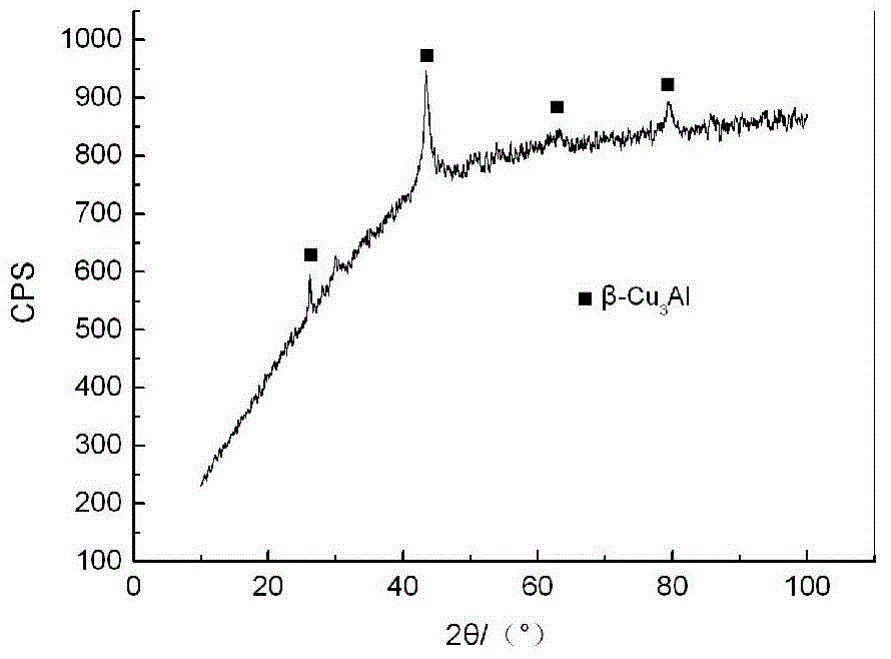A high-strength friction-reducing and wear-resistant manganese-aluminum bronze alloy
A manganese-aluminum bronze and alloy technology, applied in the field of high-strength anti-friction and wear-resistant manganese-aluminum bronze alloy, can solve the problems of decreased fatigue resistance, increased segregation phenomenon, and high price of tin, and achieves good anti-seizure and low dry friction Factor effect
- Summary
- Abstract
- Description
- Claims
- Application Information
AI Technical Summary
Problems solved by technology
Method used
Image
Examples
Embodiment 1
[0060] The raw materials are mixed according to the mass percentage: Mn8%, Al8%, Fe2.5%, Zn2.5%, Ce0.6%, and the balance Cu is smelted in a vacuum induction furnace at a melting temperature of 1230°C and kept for 10 minutes. Then, the alloy liquid with a pouring temperature of 1150°C is poured into a graphite mold with a diameter of 40 mm, and naturally cooled to obtain a circular ingot with a diameter of 40 mm; the alloy is β-Cu 3 The microhardness, tensile strength and elongation values of the Al single-phase solid solution structure are shown in Table 2; the friction and wear properties are shown in Table 3.
Embodiment 2
[0062] The raw materials are mixed according to mass percentage: Mn8.5%, Al8.5%, Fe2%, Si0.5%, Zn2%, Ce0.5%, B0.1%, and the balance Cu; smelting in a vacuum induction furnace, The melting temperature is 1240°C, and the temperature is kept for 10 minutes; then, pour the alloy solution with a pouring temperature of 1160°C into a graphite mold with a diameter of 40mm, and cool naturally to obtain a circular ingot with a diameter of 40mm; the alloy is β-Cu 3 The microhardness, tensile strength and elongation values of the Al single-phase solid solution structure are shown in Table 2; the friction and wear properties are shown in Table 3.
Embodiment 3
[0064] The raw materials are mixed according to mass percentage: Mn9%, Al9%, Fe2%, Zn2%, Ce0.7%, and the balance is Cu; it is melted in a vacuum induction furnace at a melting temperature of 1240°C and kept for 12 minutes; then, pouring The alloy liquid at a temperature of 1170°C is poured into a graphite mold with a diameter of 40mm, and naturally cooled to obtain a circular ingot with a diameter of 40mm; the alloy is β-Cu 3 The microhardness, tensile strength and elongation values of the Al single-phase solid solution structure are shown in Table 2; the friction and wear properties are shown in Table 3.
PUM
| Property | Measurement | Unit |
|---|---|---|
| microhardness | aaaaa | aaaaa |
| tensile strength | aaaaa | aaaaa |
| microhardness | aaaaa | aaaaa |
Abstract
Description
Claims
Application Information
 Login to View More
Login to View More - R&D
- Intellectual Property
- Life Sciences
- Materials
- Tech Scout
- Unparalleled Data Quality
- Higher Quality Content
- 60% Fewer Hallucinations
Browse by: Latest US Patents, China's latest patents, Technical Efficacy Thesaurus, Application Domain, Technology Topic, Popular Technical Reports.
© 2025 PatSnap. All rights reserved.Legal|Privacy policy|Modern Slavery Act Transparency Statement|Sitemap|About US| Contact US: help@patsnap.com



